|
-
5th April 17, 09:49 AM
#1
 Originally Posted by Tobus

Proscription didn't apply to those in government service, right? If these men were part of a military surveying party, I'm not sure that this is any sort of evidence one way or the other.
Proscription did not apply to those in the Army, those in Government service but not military were covered by the Act. These two might have been soldiers although the 42nd and 64th (the only two Highlander regiments at that date) wore the belted-plaid rather than the feileadh beag. The garments are similar to those in Sandby's drawing of the post-Culloden prisoners so he may have just included these to identify the surveying as working in the Highlands.
-
-
5th April 17, 11:11 AM
#2
 Originally Posted by figheadair

These two might have been soldiers although the 42nd and 64th (the only two Highlander regiments at that date) wore the belted-plaid rather than the feileadh beag. The garments are similar to those in Sandby's drawing of the post-Culloden prisoners so he may have just included these to identify the surveying as working in the Highlands.
I've no doubt that your eye for detail is better than mine with respect to Highland clothing, but do you think Sandby's paintings can be taken as accurate down to this level of detail? The post-Culloden painting appears to show the two prisoners wearing kilts with no pleats, and the tartan on the bias. Would that have been a type of kilt worn at that time period?
-
-
11th April 17, 11:34 AM
#3
 Originally Posted by Tobus

I've no doubt that your eye for detail is better than mine with respect to Highland clothing, but do you think Sandby's paintings can be taken as accurate down to this level of detail? The post-Culloden painting appears to show the two prisoners wearing kilts with no pleats, and the tartan on the bias. Would that have been a type of kilt worn at that time period?
Clearly kilts with no pleats is a contradiction but a feileadh beag with folds would be closer to what Sandby showed.
The tartan on the bias is obviously nonesense and reflects the difficulty a number of 18th century artists had with depicting tartan. The drawings of the Black Watch mutineers are a good example and their yellow and red tartan bears no resemblance to the Government sett. It may have been the case that th colouring was done later in the same way that it was for the later McIan prints.
What seems less understandable is why Sandby would have shown a feileadh beag and a sparate rolled plaid (much like the army campaign blanket worn by non-Highland soldiers) if the individuals had been wearing a feileadh mor. The style of dress he showed was certainly in use at the time of the '45 as for example, the images from Loevestein Castle attest.
-
-
11th April 17, 12:40 PM
#4
Peter,
Regarding that Red/Yellow Sett in the early Black Watch images, there are like 3 sets of images, multiple artists that show that. I almost wonder if perhaps they really did have a tartan like that?
There is of course, the Mutineer Images, this one of Farquar Shaw
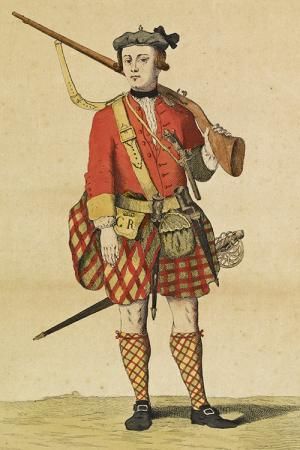
But then there are these images from the Continent, that also show Red/Yellow
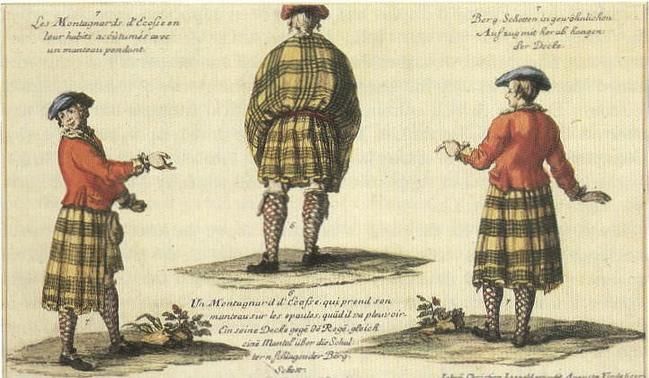
Another watercolor, from the ASK Brown Collection, hard to tell if its red yellow or something akin to Blackwatch:
The hose are certainly red/yellow
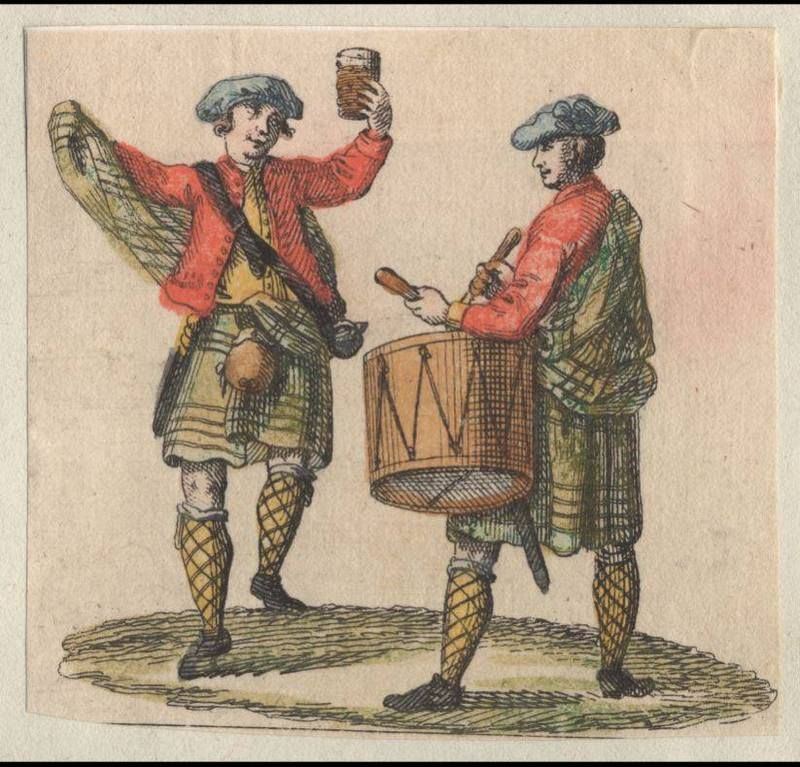
Then there is this oil, "Fashionable people thronging St James's Park", c.1745 Attributed to Joseph Nickolls
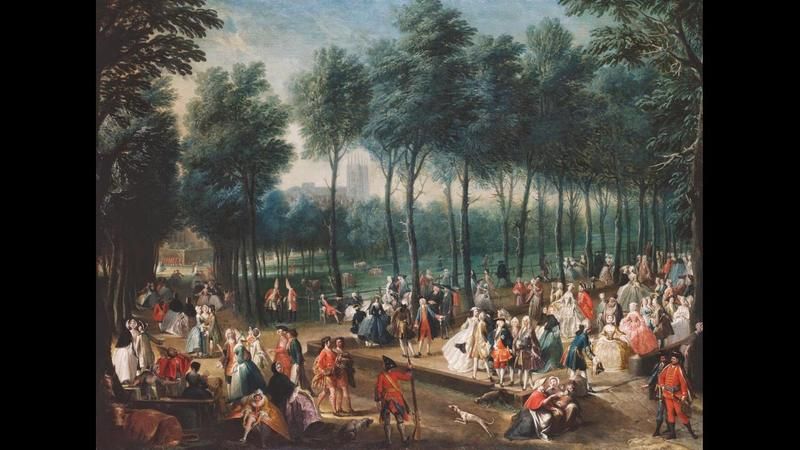
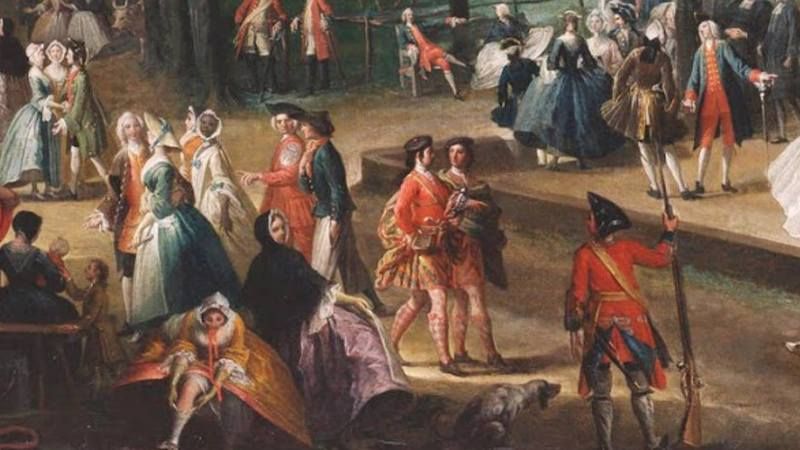
With woodcuts and watercolors there is always artistic licence or disconnect between the engraver and the person who colorized it, but sure does seem like a lot of "Artistic Licence" in the same vein in all these 45/46 era images. I have no idea if either of the 2 Col's prior to Murray have papers that survive that might shed some light on this.
-
-
12th April 17, 08:12 AM
#5
 Originally Posted by figheadair

Clearly kilts with no pleats is a contradiction but a feileadh beag with folds would be closer to what Sandby showed.
The tartan on the bias is obviously nonesense and reflects the difficulty a number of 18th century artists had with depicting tartan. The drawings of the Black Watch mutineers are a good example and their yellow and red tartan bears no resemblance to the Government sett. It may have been the case that th colouring was done later in the same way that it was for the later McIan prints.
What seems less understandable is why Sandby would have shown a feileadh beag and a sparate rolled plaid (much like the army campaign blanket worn by non-Highland soldiers) if the individuals had been wearing a feileadh mor. The style of dress he showed was certainly in use at the time of the '45 as for example, the images from Loevestein Castle attest.
Something else I just noticed is that both the prisoners are shown wearing their plaids over their right shoulders. Unless they both happened to be left-handed (very slim odds of that), wouldn't it have been customary to drape the plaid over their non-dominant (left) shoulders? This detail, while perhaps insignificant, still leads me to wonder about Sandby's accuracy. It would seem obvious that these men were not posing for a portrait, and that he had to paint it from memory of a glimpse in time. But if he got these numerous details wrong about kilts and tartans, one wonders how much "artistic license" he chose to use. It is always tempting to treat historical paintings in the same manner as modern photographs, as if they were accurate down to small details, but I tend to think that these artists were injecting a lot of non-factual information into their works.
Last edited by Tobus; 12th April 17 at 08:14 AM.
-
The Following 2 Users say 'Aye' to Tobus For This Useful Post:
-
12th April 17, 12:51 PM
#6
Tobus.
Even with photographs, assumptions are not always wise either.
" Rules are for the guidance of wise men and the adherence of idle minds and minor tyrants". Field Marshal Lord Slim.
-
The Following User Says 'Aye' to Jock Scot For This Useful Post:
-
12th April 17, 03:34 PM
#7
 Originally Posted by Tobus

Something else I just noticed is that both the prisoners are shown wearing their plaids over their right shoulders. Unless they both happened to be left-handed (very slim odds of that), wouldn't it have been customary to drape the plaid over their non-dominant (left) shoulders? This detail, while perhaps insignificant, still leads me to wonder about Sandby's accuracy. It would seem obvious that these men were not posing for a portrait, and that he had to paint it from memory of a glimpse in time. But if he got these numerous details wrong about kilts and tartans, one wonders how much "artistic license" he chose to use. It is always tempting to treat historical paintings in the same manner as modern photographs, as if they were accurate down to small details, but I tend to think that these artists were injecting a lot of non-factual information into their works.
There are a number of 18th Century images, including at least one other that I posted that show the plaid being worn on the right shoulder. I think at this time, it was not so fixed as to what shoulder a person would use. There is at least one Scottish upper body jacket/sleeved waistcoat that has loops on both shoulders. I cant call the loops epaulettets, as they are on not on the summit of the shoulder, but rather on the back slope,. Epaulettes used to secure swordbelt and cartridge box straps are always on the summit.
-
-
12th April 17, 09:23 PM
#8
 Originally Posted by Luke MacGillie

There are a number of 18th Century images, including at least one other that I posted that show the plaid being worn on the right shoulder. I think at this time, it was not so fixed as to what shoulder a person would use. There is at least one Scottish upper body jacket/sleeved waistcoat that has loops on both shoulders. I cant call the loops epaulettets, as they are on not on the summit of the shoulder, but rather on the back slope,. Epaulettes used to secure swordbelt and cartridge box straps are always on the summit.
Epaulettes were also used to hide the shoulder seam, at least in some styles of coat. This appears to be the case with 18th century Highland coats. Whether the cut reflected the need to secure a plaid is unclear but I somehow doubt it as that wouls assume that a plaid was always worn. In the case of equestrian type coats such as the 'Culloden Coat' that was not necessarily the case.
-
 Posting Permissions
Posting Permissions
- You may not post new threads
- You may not post replies
- You may not post attachments
- You may not edit your posts
-
Forum Rules
|
|
























Bookmarks